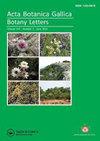Vegetation of abandoned areas in the northern Apennines (Italy): phytosociological aspects and biodiversity analysis
引用次数: 5
Abstract
Abstract We describe plant communities occurring in an abandoned area in the northern Apennines using a phytosociological approach. We evaluate the biodiversity in and between the identified plant communities using the following indices: species richness, diversity, dominance and equitability. Ten vegetation types were identified in the study area. Because of the still active dynamics only three types were classified at the association level, while the other seven types were classified at alliance level. The α-diversity is generally high in all the identified plant communities. Two main secondary successions characterize the study area: a high hilly mesophilous succession (> 800 m above sea level where precipitation is more abundant) with Knautio drymeiae-Ostryetum carpinifoliae as final stage and a low hilly thermophilous succession (< 800 m above sea level where precipitation is less abundant) with Quercus pubescens woods as final stage. Trochiscantho-Fagetum represents the final stage of a third succession that develops above 1000 m above sea level. The study area is evolving towards the final stages of the three secondary successions. This will soon cause a loss of biodiversity at different levels: landscape, vegetation communities, flora and fauna. Grasslands and low shrub communities are the most threatened communities, occupying low percentages of the study area.意大利亚平宁山脉北部废弃地区的植被:植物社会学和生物多样性分析
摘要:本文用植物社会学的方法描述了亚平宁山脉北部一个废弃地区的植物群落。利用物种丰富度、多样性、优势度和公平度等指标对已鉴定植物群落内部和群落间的生物多样性进行了评价。研究区共确定了10种植被类型。由于仍然活跃的动态,只有3种类型在关联层面被分类,而其他7种类型在联盟层面被分类。α-多样性在所有已鉴定的植物群落中普遍较高。研究区主要有两种次生演替:以干木-喀皮栎为末级的高丘陵中温演替(海拔100 ~ 800 m,降水较为丰富)和以短毛栎为末级的低丘陵热演替(海拔800 m以下,降水较少)。trochiscanthofagetum代表了在海拔1000米以上发展的第三个演替的最后阶段。研究区正在向三个次生演替的最后阶段演化。这将很快导致景观、植被群落、动植物等不同层面的生物多样性丧失。草地和低灌木群落是受威胁最严重的群落,占研究面积的百分比较低。
本文章由计算机程序翻译,如有差异,请以英文原文为准。
求助全文
约1分钟内获得全文
求助全文

 求助内容:
求助内容: 应助结果提醒方式:
应助结果提醒方式:


